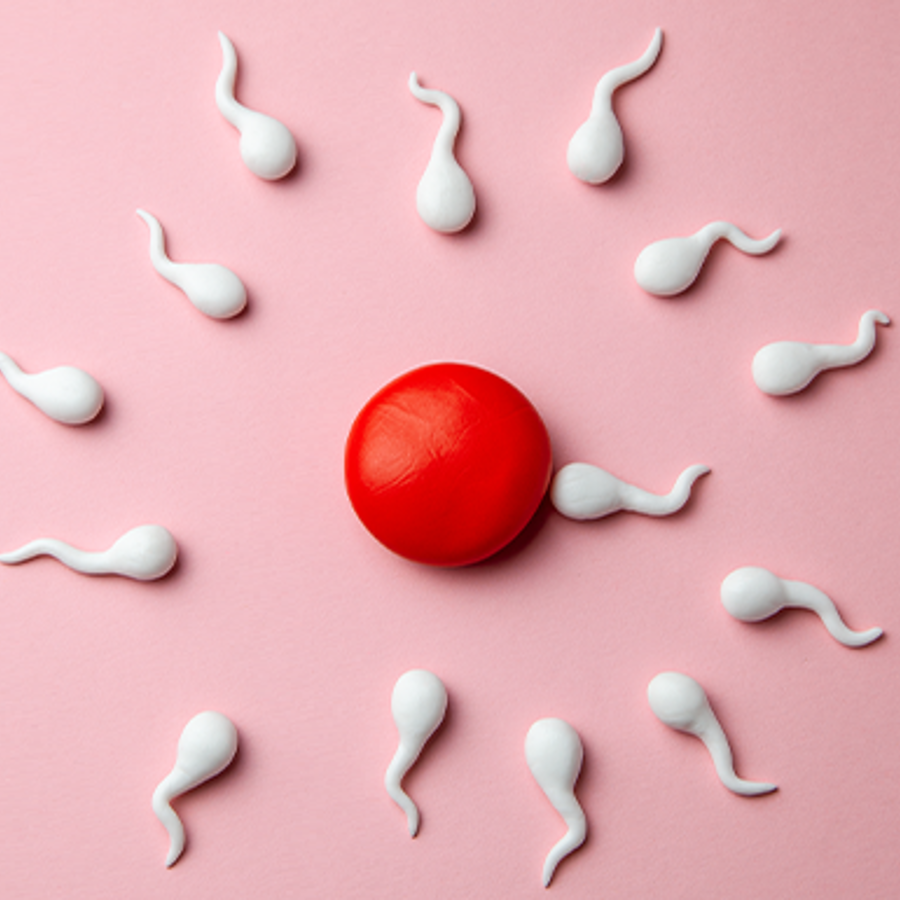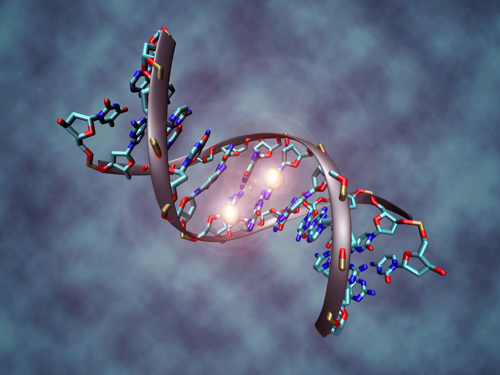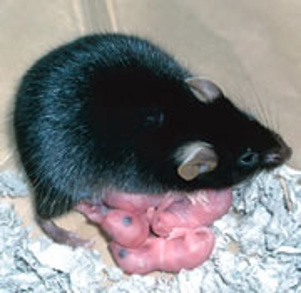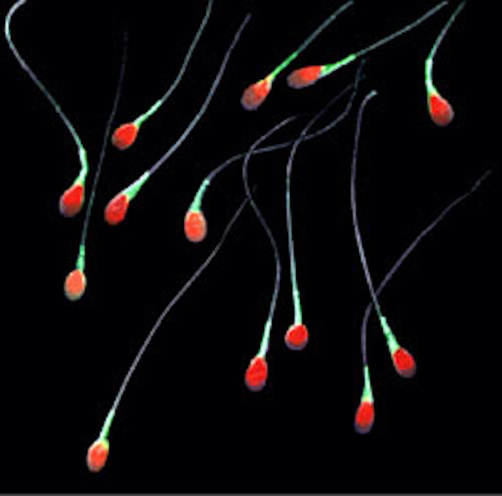
Can you generate offspring from two eggs?
May 15, 2013

- Related Topics:
- Reproduction,
- Futuristic science,
- Epigenetics,
- Chromosomes,
- Stem cells,
- Gene expression
A graduate student from Ireland asks:
“A female egg has 23 chromosomes and a male sperm also has 23 chromosomes, which is equal to 46 chromosomes and a viable embryo. What if you took the genetic material out of an egg and put it into another egg? You'd still have 46 chromosomes and that's all that's needed, right? The resulting offspring would be guaranteed female but wouldn't 46 chromosomes still result in a viable embryo as well? Even if it's from two eggs instead of an egg and sperm?”
You can’t make a baby with two moms by simply fusing two eggs or adding one egg’s DNA to another’s. Even though the resulting embryo would have the usual 46 chromosomes, this wouldn’t work.
The reason isn’t some special string of A’s, G’s, T’s or C’s found in dad’s DNA. No, instead it has to do with chemical marks found on egg and sperm DNA. This methylation (as the marks are called) makes the DNA from each parent unique, and you need both to make a baby.
What these marks do is affect how at least 80 different genes are used. In science speak, these genes are imprinted.
As you may remember, we have two copies of each of our genes, one from each biological parent. The chemical marks shut off either the copy from the egg or sperm, depending on which has the marks present..
If an embryo’s DNA came from two parents of the same sex, then both copies of some of these imprinted genes will be shut off. And for the rest of these genes, both copies will be turned on. Embryos simply can’t survive when so many genes are out of whack. In fact, diseases like Angelman syndrome, Prader-Willi syndrome, and Beckwith-Wiedemann syndrome can happen when just one of these genes isn’t passed on properly.

In the animal world, this weird little system of imprinting seems to be peculiar to all mammals except the egg laying ones like the platypus. (Imprinting also happens in flowering plants.) Other animals don’t imprint their DNA, so why do mammals?
There are a bunch of theories but one I like is that imprinting prevents something called parthenogenesis. This is a long word for a process where an egg doubles its DNA on its own and grows into a new beast without DNA from a sperm. Lots of other animals can do this, but mammals can’t. Most likely this is because imprinting prevents it from happening.
Of course for your question, the why of imprinting doesn’t matter… we only care that it is here and keeps us from fusing two eggs to make a baby. But don’t give up so easily. There may be workarounds.
One possibility, which has worked in mice, is to make one of the egg’s DNA look a bit more like a sperm’s. Another would be to coax one mom’s cells into becoming sperm. Or, if we want two dads instead, coaxing one of dad’s cells into becoming an egg.
Mouse with Two Moms
As I said, an obvious way around the problem of imprinting is to tweak one mom’s DNA so it looks more male. This is as hard as it sounds. Still, researchers managed to get two female mice to produce offspring back in 2004 by doing something very similar to this.

They started off using a mutant mouse whose females had DNA that was more male-like than typical. But they found this wasn’t enough to make offspring when combined with a second mouse’s egg.
To make offspring, the egg from the mutant female had to be combined with an immature egg from a second female. This immature egg hadn’t yet added marks to all of its DNA.
Even though the researchers got this to work, it was far from perfect. They only managed to get two daughter pups out of 457 tries1.
Now obviously this wouldn’t work for people. We can’t mutate one mom and then have hundreds of miscarriages before we get one daughter. Things have improved in mice since then but not enough to move it into people just yet.
To get a biological child with same-sex parents, we’ll probably have to get really creative. One way might be to use stem cells.
Two Moms, Two Dads
Imagine two women who want to have a child together. We’ve talked about why this is so tough to do.
But what if instead of trying to make the DNA in one woman’s egg more like a sperm’s, we coaxed some of her cells into actually becoming sperm? Or what if we could coax male cells into becoming eggs? Now two men could have a baby too

This isn’t coming to a fertility clinic near you any time soon, but it might be possible one day. The way we might do this is to take one parent’s cells, turn them into the equivalent of embryonic stem (ES) cells, and then coax them into becoming sperm or eggs.
Scientists are getting pretty good at turning cells into those magical ES cells that can become any other kind of cell. So far, though, no one has managed to make sperm or egg cells with artificially created ES cells. (Scientists call these artificially created ES cells induced pluripotent stem cells or iPS cells to distinguish them from natural ES cells.)
There are some signs of progress though. Scientists have been able to turn natural ES cells from a male mouse into a sperm cell that can fertilize an egg. This fertilized egg can even then go on to become a happy, healthy pup.
Scientists have also done similar things to create precursor egg cells from natural ES cells from a female mouse. It should only be a matter of time before they get these working with human ES cells too.
Of course this isn’t enough to do what we want yet. We first need to try to get this process to work with iPS cells. Scientists have made sperm and egg precursors from mouse iPS cells but, to my knowledge, they haven’t yet created a fertilized egg from them.
So far all of this has focused on making eggs from female cells and sperm from male cells. This will be a great boon to couples dealing with infertility, but getting male cells to become an egg or female cells a sperm will probably be much harder. Perhaps not impossible, but not as “simple” as what we’ve talked about so far.
Male and female cells are fundamentally different. Yes, turning them into ES cells should eliminate the original markings but we can’t know for sure until we try.
There may be a whiff of maleness or femaleness left in our artificially created ES cells. And as we’ve seen, it only takes a whiff to cause a genetic disease.
But still, we may one day be able to pull off what you suggest. Then, same-sex partners might be able to have biological children.

Author: Dr. Barry Starr
Barry served as The Tech Geneticist from 2002-2018. He founded Ask-a-Geneticist, answered thousands of questions submitted by people from all around the world, and oversaw and edited all articles published during his tenure. AAG is part of the Stanford at The Tech program, which brings Stanford scientists to The Tech to answer questions for this site, as well as to run science activities with visitors at The Tech Interactive in downtown San Jose.
 Skip Navigation
Skip Navigation
